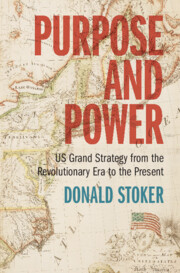Refine search
Actions for selected content:
15401 results in Military history

Purpose and Power
- US Grand Strategy from the Revolutionary Era to the Present
-
- Published online:
- 11 January 2024
- Print publication:
- 11 January 2024
Conclusion
- from Part IV - Retreat and Defeat
-
- Book:
- Purpose and Power
- Published online:
- 11 January 2024
- Print publication:
- 11 January 2024, pp 696-703
-
- Chapter
- Export citation
12 - The Vietnam War, 1961–1969
- from Part II - From Great Power to Superpower
-
- Book:
- Purpose and Power
- Published online:
- 11 January 2024
- Print publication:
- 11 January 2024, pp 416-445
-
- Chapter
- Export citation
1 - The Fight for Sovereignty, 1775–1801
- from Part I - From Backwater to Great Power
-
- Book:
- Purpose and Power
- Published online:
- 11 January 2024
- Print publication:
- 11 January 2024, pp 14-49
-
- Chapter
- Export citation
Thinking about Grand Strategy in Peace and War
-
- Book:
- Purpose and Power
- Published online:
- 11 January 2024
- Print publication:
- 11 January 2024, pp 1-12
-
- Chapter
- Export citation
18 - Wilsonian Revolutionaries: The Bush Administration, 2001–2009
- from Part III - The Post–Cold War World
-
- Book:
- Purpose and Power
- Published online:
- 11 January 2024
- Print publication:
- 11 January 2024, pp 589-630
-
- Chapter
- Export citation
Part III - The Post–Cold War World
-
- Book:
- Purpose and Power
- Published online:
- 11 January 2024
- Print publication:
- 11 January 2024, pp 535-630
-
- Chapter
- Export citation
5 - Conquering a Continent: The Indian wars, 1865–1897
- from Part I - From Backwater to Great Power
-
- Book:
- Purpose and Power
- Published online:
- 11 January 2024
- Print publication:
- 11 January 2024, pp 156-190
-
- Chapter
- Export citation
7 - Stepping upon the Global Stage, 1913–1921
- from Part II - From Great Power to Superpower
-
- Book:
- Purpose and Power
- Published online:
- 11 January 2024
- Print publication:
- 11 January 2024, pp 227-257
-
- Chapter
- Export citation
15 - Winning the Hot Peace: Reagan’s Great-Power Competition, 1981–1990
- from Part II - From Great Power to Superpower
-
- Book:
- Purpose and Power
- Published online:
- 11 January 2024
- Print publication:
- 11 January 2024, pp 497-534
-
- Chapter
- Export citation
Part I - From Backwater to Great Power
-
- Book:
- Purpose and Power
- Published online:
- 11 January 2024
- Print publication:
- 11 January 2024, pp 13-224
-
- Chapter
- Export citation
Abbreviations
-
- Book:
- Purpose and Power
- Published online:
- 11 January 2024
- Print publication:
- 11 January 2024, pp xi-xii
-
- Chapter
- Export citation
13 - Détente and Defeat: Nixon, Ford, and Vietnam, 1969–1977
- from Part II - From Great Power to Superpower
-
- Book:
- Purpose and Power
- Published online:
- 11 January 2024
- Print publication:
- 11 January 2024, pp 446-476
-
- Chapter
- Export citation
2 - Expansion, Sovereignty, and War, 1801–1817
- from Part I - From Backwater to Great Power
-
- Book:
- Purpose and Power
- Published online:
- 11 January 2024
- Print publication:
- 11 January 2024, pp 50-76
-
- Chapter
- Export citation
Figures
-
- Book:
- Purpose and Power
- Published online:
- 11 January 2024
- Print publication:
- 11 January 2024, pp ix-ix
-
- Chapter
- Export citation
11 - The Hot Peace: The Eisenhower, Kennedy, And Johnson Years, 1953–1969
- from Part II - From Great Power to Superpower
-
- Book:
- Purpose and Power
- Published online:
- 11 January 2024
- Print publication:
- 11 January 2024, pp 390-415
-
- Chapter
- Export citation
10 - The Hot Peace and the Korean War, 1945–1953
- from Part II - From Great Power to Superpower
-
- Book:
- Purpose and Power
- Published online:
- 11 January 2024
- Print publication:
- 11 January 2024, pp 344-389
-
- Chapter
- Export citation
6 - American Empire, 1897–1913
- from Part I - From Backwater to Great Power
-
- Book:
- Purpose and Power
- Published online:
- 11 January 2024
- Print publication:
- 11 January 2024, pp 191-224
-
- Chapter
- Export citation
Acknowledgements
-
- Book:
- Purpose and Power
- Published online:
- 11 January 2024
- Print publication:
- 11 January 2024, pp 704-704
-
- Chapter
- Export citation
8 - The Interwar Interlude, 1921–1939
- from Part II - From Great Power to Superpower
-
- Book:
- Purpose and Power
- Published online:
- 11 January 2024
- Print publication:
- 11 January 2024, pp 258-293
-
- Chapter
- Export citation
